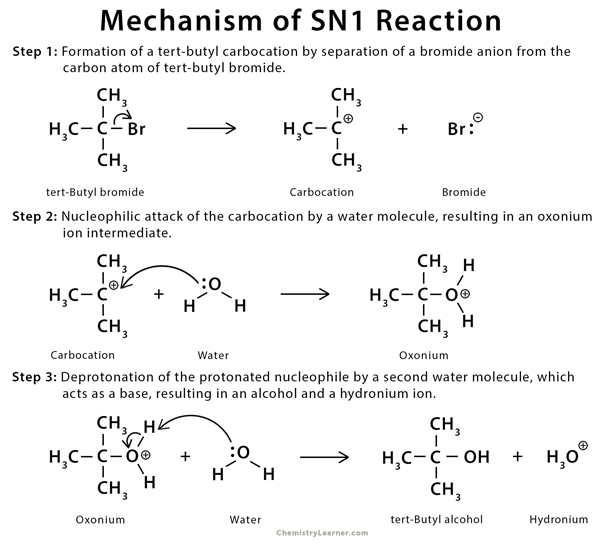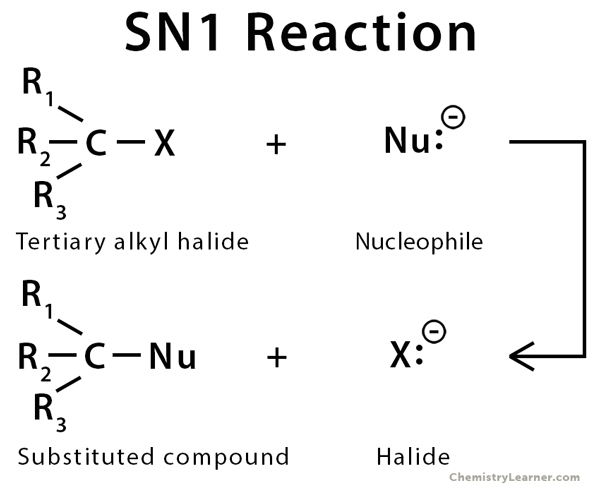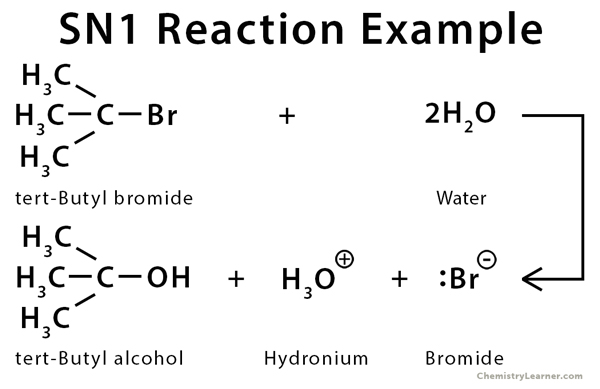SN1 Reaction
Definition: What is SN1 Reaction?
Nucleophiles, typically, have a lone pair of electrons in them. As the name suggests, they are attracted to the nucleus of an atom. The SN1 reaction is a type of nucleophilic substitution reaction in which an electron-rich nucleophile displaces the halogen atom bonded to the central carbon of an alkyl halide molecule. The halide ion that is displaced from the carbon atom is called the leaving group. SN1 reaction takes place at the site of a saturated carbon atom. Some typical nucleophiles are halide (X–), hydroxy group (OH–), alkoxy group (RO–), cyanide ion (CN–), hydrogen sulfide (H2S), ammonia (NH3), and water (H2O) [1-5].
Characteristics of SN1 Reaction
- Two-step reaction process: 1. carbon-halogen bond breaks, resulting in a positively charged carbon (carbocation) and 2. nucleophile attacks the carbocation, forming a new bond
- Unimolecular and follows first-order kinetics
- Rate of the reaction depends on the concentration of the substrate (alkyl halide)
- Has a racemization stereochemistry, i.e., both retention and inversion products are formed
- Polar protic solvent is used to enhance the reactivity
- Mostly occurs in tertiary and secondary alkyl halide, with the former having a higher reaction rate than the latter
Example of SN1 Reaction
The SN1 reaction is commonly observed in tertiary alkyl halide [1].
Factors Affecting SN1 Reaction
An excellent leaving group favors the SN1 reaction. A good leaving group is one whose bond with carbon can be easily broken and is, generally, a weak base. The order of reactivity of halides towards SN1 reaction is I–>Br–>Cl–>F–. In other words, the C-I bond is easy to break than the C-F bond, making the former susceptible to nucleophilic attack [6].
Mechanism of SN1 Reaction [9-13]
The mechanism of SN1 reaction involves breaking the carbon-halogen bond to form a carbocation intermediate, followed by the addition of the nucleophile [1,7-9].

FAQs
Ans. If a primary haloalkane did use this mechanism, a primary carbocation would be formed, which is much more energetically unstable than the tertiary one formed from tertiary haloalkanes. Therefore, it is much more challenging to produce.
References
- Definition, example and mechanism – Byjus.com
- Definition – Chem.ucalgary.ca
- Definition – Masterorganicchemistry.com
- Definition – Chem.ox.ac.uk
- Definition – Chem.libretexts.org
- Factors – Chem.libretexts.org
- Mechanism – Chem.ucalgary.ca
- Mechanism – Chemhelper.com
- Mechanism – Organic-chemistry.org






